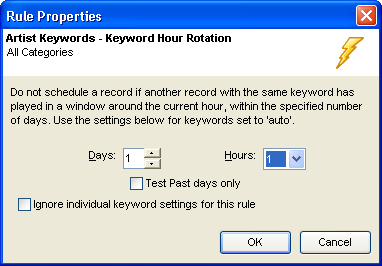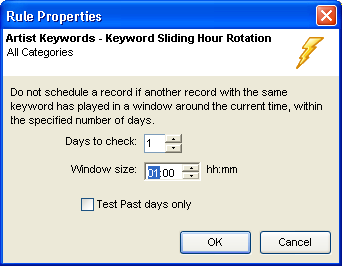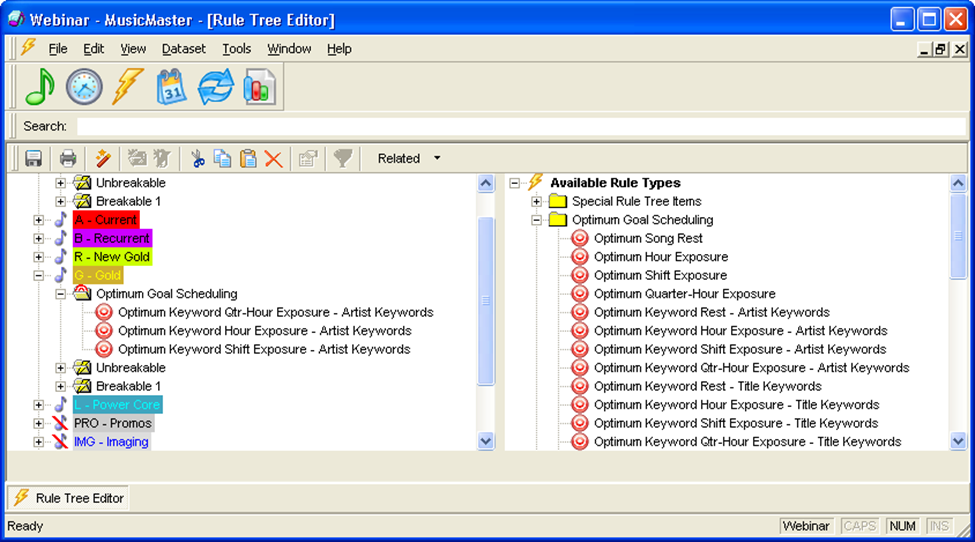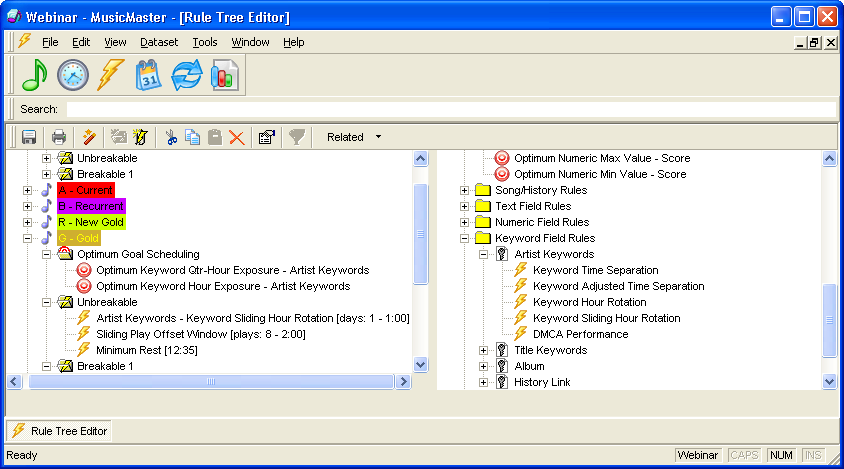MusicMaster Blog
MusicMaster TSL Booster Rules! posted on November 14th, 2011
By Marianne Burkett
In the Programming department of any radio station, the final product flowing from the speakers is really all that matters. Compelling content, cool promotions, contests and stand out imaging, news and weather are important, but well-crafted music logs are really key to spiking the stations Time Spent Listening.
I can’t speak for every station… but most have a limited, well-researched music list. How to optimize that list with MusicMaster is nearly limitless. We have developed some great rules that help you get the job done right via the Automatic Scheduler.
Let’s begin by setting our alarms to your station. It’s 6am and your alarm clock goes off. Maybe it’s news, maybe it’s a song at the top of the hour. I’m groggy and don’t really want to open my eyes yet, so…I listen for the end of the news or end of the song before I give up and get out of bed. You remember the movie Groundhog Day? Every day the same song was on. That’s not your station is it? Is the same artist playing at the same time? If so – we can help you out by installing some rules that move the artists…either from hour to hour or within the hour. For the artist rules, there are three different ways to approach:
1. Artist Keyword Hour Rotation
 This rule will stop an artist from playing in the same hour within the specified number of days. In the example above the rule will protect 1 day back and keep it out of the same hour. That means from :00 through :59. If today the artist plotted at 6am, it would not allow that artist to plot within the 6am hour tomorrow. However, it would be allowed to schedule at 5:59am or 7:00am the following day.
This rule will stop an artist from playing in the same hour within the specified number of days. In the example above the rule will protect 1 day back and keep it out of the same hour. That means from :00 through :59. If today the artist plotted at 6am, it would not allow that artist to plot within the 6am hour tomorrow. However, it would be allowed to schedule at 5:59am or 7:00am the following day.
2. Artist Keyword Sliding Hour Rotation
 What this rule can do for you is a bit more flexible than the basic Artist Hour Rotation. In the example above, the rule is looking back one day and the “window” is 1 hour. So if an artist played at 6am today, tomorrow the 1 hour window is protecting 30 minutes either side of the play, thus allowing the artist to play at 5:30am or 6:30am.
What this rule can do for you is a bit more flexible than the basic Artist Hour Rotation. In the example above, the rule is looking back one day and the “window” is 1 hour. So if an artist played at 6am today, tomorrow the 1 hour window is protecting 30 minutes either side of the play, thus allowing the artist to play at 5:30am or 6:30am.
3. Last but not least are MusicMaster exclusive “Optimum Goal Scheduling Rules”. We have several that address Artist Hour Rotation issues.
 When you use Optimum Goal Scheduling rules, they should only be used in categories that have Search Depth. All songs that pass the unbreakable rules in the search depth are passed on to the Goals. The Goals are then used to determine the best available song. The Goals are “scaled” so the top Goal is considered the most important. This is the same way your Breakable rules work. You can install a “hard” rule like the Keyword Sliding Hour Rotation rule and also install the Goals to improve your results. That essentially gives you a minimum standard that must be met before the Goals come into play.
When you use Optimum Goal Scheduling rules, they should only be used in categories that have Search Depth. All songs that pass the unbreakable rules in the search depth are passed on to the Goals. The Goals are then used to determine the best available song. The Goals are “scaled” so the top Goal is considered the most important. This is the same way your Breakable rules work. You can install a “hard” rule like the Keyword Sliding Hour Rotation rule and also install the Goals to improve your results. That essentially gives you a minimum standard that must be met before the Goals come into play.
 One final important note about the use of Goals: especially the Quarter Hour Goals. If a category is only in one quarter hour in your clocks, the Quarter Hour Goals shouldn’t be used. In addition if you have a category that only plays in the noon hour – you shouldn’t use the Hour Exposure rule. Be sure to check the rules you are using and make sure they make sense for each category.
One final important note about the use of Goals: especially the Quarter Hour Goals. If a category is only in one quarter hour in your clocks, the Quarter Hour Goals shouldn’t be used. In addition if you have a category that only plays in the noon hour – you shouldn’t use the Hour Exposure rule. Be sure to check the rules you are using and make sure they make sense for each category.
As always, if you have any questions about the Rules and best way to utilize them, call or email your Music Scheduling Consultant!

